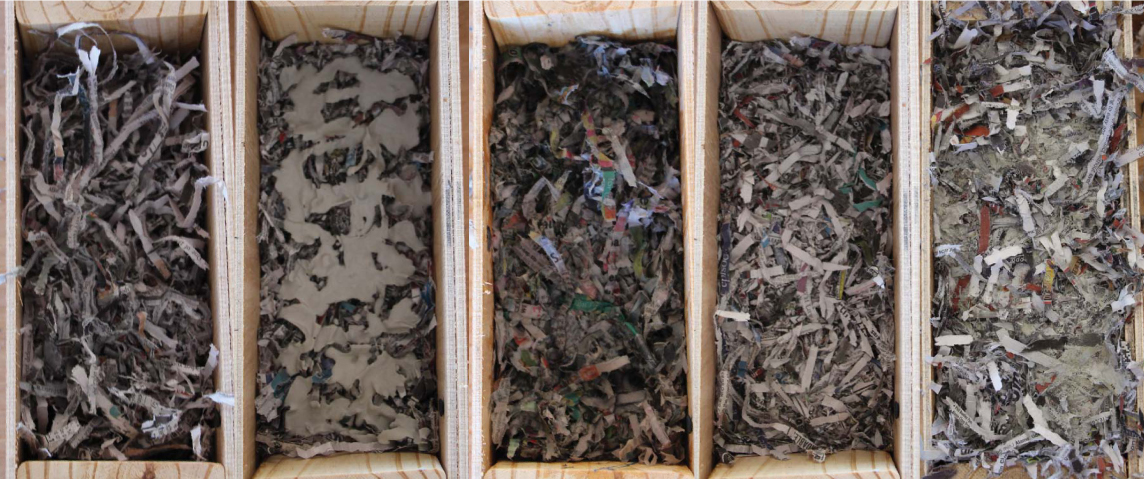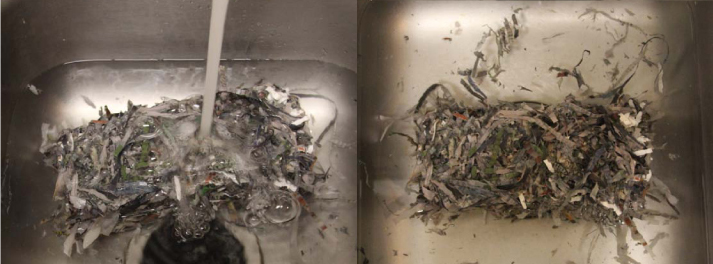As part of my studio with John Ronan this semester, we started with material studies. Since our project this semester is about transforming an urban site into a final resting place for Chicago’s unclaimed dead, my material was also about how to use something eminently disposable—yesterday’s newspaper—into something useful and permanent.
Newspaper is quick to decompose. I wanted to explore how it could be used as a building material, so I tried a couple of methods to mix it with cement to make it structural and permanent.
The process I landed upon was layering shredded newspaper with thin layers of concrete within form work. It’s a long process and labor intensive.
I laid down a thin layer of dry shredded newspaper first. Then I would drizzle a thing layer of cement. Next I would press it together so that the cement and the newspaper fully mixed. Then I’d lay down the next layer of newspaper, and so on. Each layer of newspaper was thing enough that the cement was always accessible to the next layer so the entire mold could dry and cure as a single piece of cement.
I thought this could create a really interesting type of wall because the newspaper would slowly flake off or dissolve over time. It would have an interesting texture and would appear to be entirely newspaper, but would actually be mostly cement. It also leaves no residue on the form work.
After making a number of these newspaper concrete blocks, I tested how they were fare under various types of exposure: fire, water, ice, and weather.
Fire: I put the block on a bbq block in my apartment complex and tried really hard to light it on fire with a firestarter. As I thought might be the case, it was pretty difficult. I think this is because it’s so compacted that the fire wasn’t able to travel too far.
The next thing I want to try to do is light an actual fire and then put the block in the middle. Perhaps if it’s in a really hot, established fire, it might catch on fire better. I want to see what will happen if the newspaper catches on fire all the way through. I don’t know if it will leave cavities or if it will collapse or what.
Water: I wasn’t actually trying to accurately model the effect of rain here, I was just trying to soak the block all the way through so that I could freeze it. (I have another example from actual rain.) I did find out that hard rain/flooding will cause a lot of the loose pieces to float off. It doesn’t really look any different afterwards though.
Ice: I wanted to see if the water would expand enough when it froze to break the cement apart, because that would be bad. Luckily, it didn’t.
A little bit of frost did form along the newspaper, but not much in my freezer. I was hoping as well that maybe icicles would form on some of the loose newspaper pieces—although I knew that the conditions wouldn’t be correct. I still have reason to believe some would form from the ice that did form at the bottom.
I think the edges would have to be loosened a bit more to have pieces dangling off the edges for icicles to form. Otherwise, I think the compression of the newspaper pieces that inhibited the fire would also inhibit the formation of icicles.
Weather exposure: It rained a lot in Austin, and has fluctuated in temperature from 50s to 90s. I have left a block outside. I plan on leaving it out there all semester. By final review, it will have been exposed for 10 weeks and, most likely, through at least a 40 degree temperature range.
So far, it’s been pretty soaked, but didn’t noticeably degrade under a lot of rain. From the sun, however, it has turned quite yellow.





